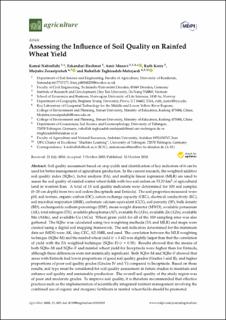| dc.description.abstract | Soil quality assessment based on crop yields and identification of key indicators of it can be used for better management of agricultural production. In the current research, the weighted additive soil quality index (SQIw), factor analysis (FA), and multiple linear regression (MLR) are used to assess the soil quality of rainfed winter wheat fields with two soil orders on 53.20 km2 of agricultural land in western Iran. A total of 18 soil quality indicators were determined for 100 soil samples (0–20 cm depth) from two soil orders (Inceptisols and Entisols). The soil properties measured were: pH, soil texture, organic carbon (OC), cation exchange capacity (CEC), electrical conductivity (EC), soil microbial respiration (SMR), carbonate calcium equivalent (CCE), soil porosity (SP), bulk density (BD), exchangeable sodium percentage (ESP), mean weight diameter (MWD), available potassium (AK), total nitrogen (TN), available phosphorus (AP), available Fe (AFe), available Zn (AZn), available Mn (AMn), and available Cu (ACu). Wheat grain yield for all of the 100 sampling sites was also gathered. The SQIw was calculated using two weighting methods (FA and MLR) and maps were created using a digital soil mapping framework. The soil indicators determined for the minimum data set (MDS) were AK, clay, CEC, AP, SMR, and sand. The correlation between the MLR weighting technique (SQIw-M) and the rainfed wheat yield (r = 0.62) was slightly larger than that the correlation of yield with the FA weighted technique (SQIw-F) (r = 0.58). Results showed that the means of both SQIw-M and SQIw-F and rainfed wheat yield for Inceptisols were higher than for Entisols, although these differences were not statistically significant. Both SQIw-M and SQIw-F showed that areas with Entisols had lower proportions of good soil quality grades (Grades I and II), and higher proportions of poor soil quality grades (Grades IV and V) compared to Inceptisols. Based on these results, soil type must be considered for soil quality assessment in future studies to maintain and enhance soil quality and sustainable production. The overall soil quality of the study region was of poor and moderate grades. To improve soil quality, it is therefore recommended that effective practices such as the implementation of scientifically integrated nutrient management involving the combined use of organic and inorganic fertilizers in rainfed wheat fields should be promoted. | en_US |

